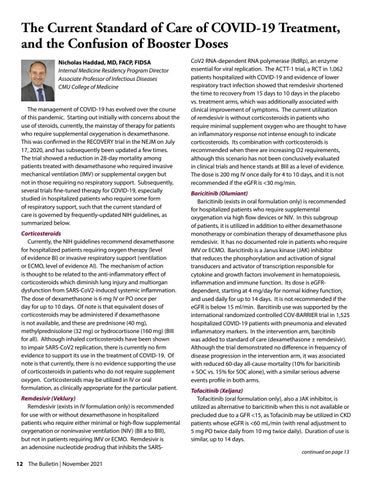The Current Standard of Care of COVID-19 Treatment, and the Confusion of Booster Doses Nicholas Haddad, MD, FACP, FIDSA Internal Medicine Residency Program Director Associate Professor of Infectious Diseases CMU College of Medicine
The management of COVID-19 has evolved over the course of this pandemic. Starting out initially with concerns about the use of steroids, currently, the mainstay of therapy for patients who require supplemental oxygenation is dexamethasone. This was confirmed in the RECOVERY trial in the NEJM on July 17, 2020, and has subsequently been updated a few times. The trial showed a reduction in 28-day mortality among patients treated with dexamethasone who required invasive mechanical ventilation (IMV) or supplemental oxygen but not in those requiring no respiratory support. Subsequently, several trials fine-tuned therapy for COVID-19, especially studied in hospitalized patients who require some form of respiratory support, such that the current standard of care is governed by frequently-updated NIH guidelines, as summarized below. Corticosteroids Currently, the NIH guidelines recommend dexamethasone for hospitalized patients requiring oxygen therapy (level of evidence BI) or invasive respiratory support (ventilation or ECMO, level of evidence AI). The mechanism of action is thought to be related to the anti-inflammatory effect of corticosteroids which diminish lung injury and multiorgan dysfunction from SARS-CoV2-induced systemic inflammation. The dose of dexamethasone is 6 mg IV or PO once per day for up to 10 days. Of note is that equivalent doses of corticosteroids may be administered if dexamethasone is not available, and these are prednisone (40 mg), methylprednisolone (32 mg) or hydrocortisone (160 mg) (BIII for all). Although inhaled corticosteroids have been shown to impair SARS-CoV2 replication, there is currently no firm evidence to support its use in the treatment of COVID-19. Of note is that currently, there is no evidence supporting the use of corticosteroids in patients who do not require supplement oxygen. Corticosteroids may be utilized in IV or oral formulation, as clinically appropriate for the particular patient. Remdesivir (Veklury) Remdesivir (exists in IV formulation only) is recommended for use with or without dexamethasone in hospitalized patients who require either minimal or high-flow supplemental oxygenation or noninvasive ventilation (NIV) (BII a to BIII), but not in patients requiring IMV or ECMO. Remdesivir is an adenosine nucleotide prodrug that inhibits the SARS12 The Bulletin | November 2021
CoV2 RNA-dependent RNA polymerase (RdRp), an enzyme essential for viral replication. The ACTT-1 trial, a RCT in 1,062 patients hospitalized with COVID-19 and evidence of lower respiratory tract infection showed that remdesivir shortened the time to recovery from 15 days to 10 days in the placebo vs. treatment arms, which was additionally associated with clinical improvement of symptoms. The current utilization of remdesivir is without corticosteroids in patients who require minimal supplement oxygen who are thought to have an inflammatory response not intense enough to indicate corticosteroids. Its combination with corticosteroids is recommended when there are increasing O2 requirements, although this scenario has not been conclusively evaluated in clinical trials and hence stands at BIII as a level of evidence. The dose is 200 mg IV once daily for 4 to 10 days, and it is not recommended if the eGFR is <30 mg/min. Baricitinib (Olumiant) Baricitinib (exists in oral formulation only) is recommended for hospitalized patients who require supplemental oxygenation via high flow devices or NIV. In this subgroup of patients, it is utilized in addition to either dexamethasone monotherapy or combination therapy of dexamethasone plus remdesivir. It has no documented role in patients who require IMV or ECMO. Baricitinib is a Janus kinase (JAK) inhibitor that reduces the phosphorylation and activation of signal transducers and activator of transcription responsible for cytokine and growth factors involvement in hematopoiesis, inflammation and immune function. Its dose is eGFRdependent, starting at 4 mg/day for normal kidney function, and used daily for up to 14 days. It is not recommended if the eGFR is below 15 ml/min. Barcitinib use was supported by the international randomized controlled COV-BARRIER trial in 1,525 hospitalized COVID-19 patients with pneumonia and elevated inflammatory markers. In the intervention arm, barcitinib was added to standard of care (dexamethasone ± remdesivir). Although the trial demonstrated no difference in frequency of disease progression in the intervention arm, it was associated with reduced 60-day all-cause mortality (10% for baricitinib + SOC vs. 15% for SOC alone), with a similar serious adverse events profile in both arms. Tofacitinib (Xeljanz) Tofacitinib (oral formulation only), also a JAK inhibitor, is utilized as alternative to baricitinib when this is not available or precluded due to a GFR <15, as Tofacinib may be utilized in CKD patients whose eGFR is <60 mL/min (with renal adjustment to 5 mg PO twice daily from 10 mg twice daily). Duration of use is similar, up to 14 days. continued on page 13


